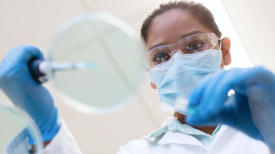- Cancer Care Team
Cancer Care Team
To deliver optimal patient outcomesProducts and Services
Cancer Type
Supplies & Tools
Scientific Focus
- Biopharma Partners
- Patients
- Education & Events
- Login
- Contact Us
Test Details
 Cancer Type
Cancer Type
Hematologic malignancies, Myeloma
 Technology Used
Technology Used
FISH
 Turnaround Time
Turnaround Time
5 - 7 days
Use
This is a diagnostic test for multiple myeloma. Plasma cell enrichment diagnosis increased as much as 50% to 100%. The FISH results on the enriched assay should not be used as a quantitative assay, since the abnormal cells do not represent the percentage of abnormal cells in the aspirate.
Special Instructions
Indicate pertinent clinical diagnosis and previous cytogenetics studies on the test request form. If insufficient plasma cells are available, the following probe priority will be followed: Previous abnormality, p53, FGFR3/IGH, MAF/IGH, 1p/1q, 13q14, CCND1/IGH, 7/9/15 aneuploidy probes. If a chromosome study (510999) is ordered concurrently and sample is not sufficient for both tests, FISH will be prioritized.
Test Includes
Fluorescence in situ hybridization (FISH) for multiple myeloma (MM), targeting 13q14, IGH/CCND1, TP53, FGFR1/IGH, cMAF/IGH, amplification of 1p/1q, on plasma enriched cells.
Limitations
Molecular mutations or chromosomal alterations not targeted by the probe included in this profile will not be detected.
This test was developed and its performance characteristics determined by Labcorp. It has not been cleared or approved by the Food and Drug Administration.
Methodology
Fluorescence in situ hybridization (FISH) and plasma cell enrichment
Specimen Requirements
Information on collection, storage, and volume
Specimen
Bone marrow
Volume
1 to 3 mL bone marrow
Minimum Volume
1 mL bone marrow
Container
Green-top (sodium heparin) tube; pediatric Vacutainer® is optimal or lavender-top (EDTA) tube (suboptimal). For samples with shared karyotype (510999) and any FISH study in the same tube, EDTA is not recommended due to the growth inhibition in cell culture. Adjust tube size to sample volume to avoid heparin toxicity.
Storage Instructions
Maintain specimen at room temperature.
Causes for Rejection
Whole blood; broken Vacutainer®; specimen received at testing facility 72 hours after collection
Collection
Utilize sterile technique and Labcorp transport kits when possible.
Related Tests
Find more tests related to this one.





